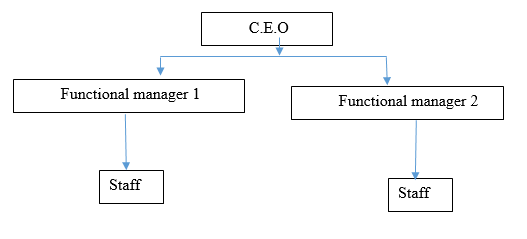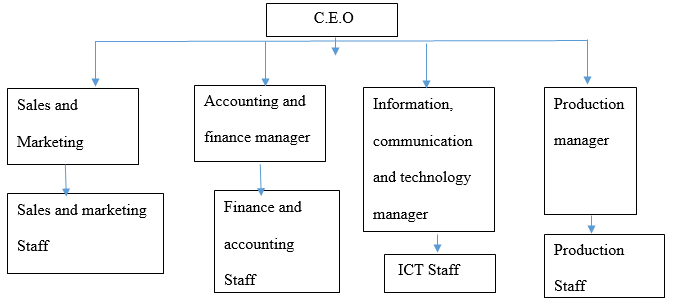- Pick any organisational structure of your choice – just one. Explain the structure, as well as its advantages and disadvantages.
Functional organization structure is the most applied type of organization structure in which firms groups its employees in accordance to work specialization (Meyer, 1977). When this type of structure is applied, persons with similar or related skills and knowledge, ideally playing the same or related roles an organization are grouped together. The distribution of tasks as well the chain of command is such organizations will thus follow this logic. A functional organizational structure outlay may take the following form:
As shown on the above outlay, departmentalization in firms applying functional organization is also done on the grounds of work specialization yielding a structure as the one below:
Advantages of functional organization
The most conspicuous characteristic of functional organization structure is grouping of persons with similar functions thus skills and knowledge together. With this comes the ability of employees to exercise specialization and thus develop expertise in their line of work both as individuals and as the small teams they are grouped into (Meyer, 1977 ). In additions, this type of organization structure allows for skills development among employees making a firm more effective in realizing its functional goals. Secondly, specialization is known for its ability to enhance productivity. As employees are grouped into and manned my person of similar functions they are able to work with confidence and thus effectively.
Disadvantages of functional management
Due to the bureaucracy that results from implementation of functional organization structure, there arises a possibility of communication breakdown. In addition, decision making processes are prolonged and the lags that herein result may affect performance and productivity of the organization especially when speedy decision making is key.
- What are emotions? Give a general overview. Also, select one negative emotion and one positive emotion, and explain the impact they have in the workplace.
Emotions also referred to as feelings are psychological states that yield temporal experiences towards specific individuals or in response to specific occurrences (Pace, 2006). Examples of commonly felt emotions include anger, fear, sadness, happiness and surprise. Such feelings have psychological impact on individuals altering the way they behave and at times affecting the metabolic activities such as heart beats. There are two major types of emotions inclusive of positive and negative emotions which are further subdivided into high activation negative emotions, high activation positive emotions, low activation positive emotions and low activation negative emotions. When felt in the work place, emotions have a prospective to yield either positive or negative effects
Effects of envy in the work place (negative emotion)
Every individual is motivated by internal and/or external factors. Envy may come as a result of external factors such as varied remunerations in the work place but results into internal effects (Williams, 2013). The most conspicuous result of envy is reluctance. Employees who feel like others are highly rated than them or as though the efforts of everyone else accept them is appreciated may end up working below their ability and their performance would definitely reflect the level of efforts they put into their work.
Effects of enthusiasm in the workplace (positive emotions)
Enthusiasm is a feeling of energetic interest towards an activity backed up by the eagerness to take part in it or a deep desire to see its outcome. When employees feel enthusiastic, they are willing to work and excited about achievements resulting from their labor. Enthusiasm offers a sense of direction which yields timely decision making and inherently good performance (Pace, 2006). In most cases enthusiasm is thus seen to be a source of intrinsic motivation towards performance and achievement of certain goals. When for example employees are enthusiastic about a new product they will put in all possible efforts towards playing their individual roles in its success thus guaranteeing effective productivity of labor, at time exceeding the expectations of their employer.
- Select one characteristic of an effective team – any characteristic of your choice. Explain the definition of your characteristic, how it relates to teamwork, and how this makes for a better work environment.
Clear roles and work assignment
This is when individual members of a team have been issued a clear scope of work, may be based on their job description. This characteristic is related to team performance at work in that where it exists, individuals clearly understand what is expected of them as well as what to expect from other members of the team.
Clear roles and work assignment is an import part of team performance (Machado & Davim, 2016). To start with, where such clarity of scope lacks, distribution of resources among employees may be affect. As such clear job allocations assist in proper distribution of resources at any given point and time. In addition, when employees have a clear understanding of what they are expected to do, they are likely to be more motivated to do it than when they are not clear on what to do when. This is so because when clarity exists, with it comes confidence and possibilities of personal evaluations on the presence of skills and abilities as well as preparation and efficiency development. Thirdly, communication within the team is enhanced and made more effective since it is possible for one to know whom they are to contact when and the extent to which they may expect assistance from any individual team member. As a results of the pros of clear role definition, efficiency and effectiveness in individual performance is achieved.
Rather than individual performance, the performance of the team as a whole may also be boosted through clarity of scope. According to (Williams, 2013), this may be attained through reduction of conflicts within the team. As such clear assignments with make best use of skills and information within a team as unnecessary competitions and conflicting interests are reduced. In the presence of clear work assignments, team members work as more of complements than competitors thus enhancing both their individual and collective performance.
References
AlHashemi, S., & Tzudiker, R. (2012). Workplace emotions: Emotional intelligence in Bahraini management.
Burton, R. M., Obel, B., & Håkonsson, D. D. (2015). Organizational Design. West Nyack: Cambridge University Press.
Films on Demand. (2011). Organizational structure: 1. Hamilton, NJ: Films Media Group [distributor.
Frijda, N. H. (2001). The emotions. Cambridge [u.a.: Cambridge Univ. Press [u.a.
Library Video Network. (2014). Teamwork basics.
Machado, C., & Davim, J. P. (2016). Organizational Management. London: Palgrave Macmillan UK.
Meyer, M. W. (1977). Theory of organizational structure. Indianapolis: Bobbs-Merrill.
Pace, J. (2006). The workplace. New York: Mcgraw-Hill.
Williams, C. (2013). Management. Mason, OH: South-Western Cengage Learning.








